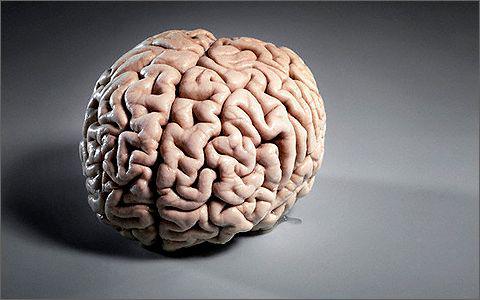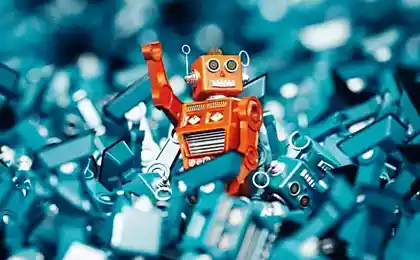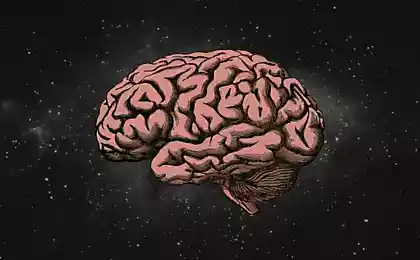573
6 strange theories about the origin of human intelligence
As a result, thousands of years of evolution of man was unusually developed (compared to the others, even the most intelligent animal) intellect. But what made us unique? What is the evolutionary path we have done? Of course, to get a definite answer to these questions, we are unlikely to succeed, but some of the assumptions we may do, even if they sound pretty weird.

1. A mutation that has spread from a single ancient human
Evolutionary changes can occur in two ways:
First - microevolution, that is, small, incremental changes for a long time.
Second - macroevolution, that is a sharp jump in the development of an organism.
On the interaction of these two processes, there are several theories, one of which is known as "macromutations" - a genetic disorder, in which one individual is obtained quite "special", unlike their relatives. In fact, this is a new species (remember even mutants of the «X-Men»).
Oxford University neuroscientist Colin Blakemore believes that man was the same. Some of our ancestors had been grown with a severe genetic defect that made him or her a little smarter than the rest of the ancient people. It was an absolute accident, which turned out to be quite useful in terms of survival, and the man gave this a "defect" is inherited.
2. Feature DNA
The project of the human genome, researchers found in our DNA something quite unique: double gene SRGAP2, which is known to be responsible for the development of the brain.
No other primate (and none at all in the same animal, for that matter), there is nothing of the sort. That is likely at some point in human history there was a "glitch».
In fact, we have several copies of SRGAP2, which mainly represent a "genetic junk" and called SRGAP2B and SRGAP2D.
But SRGAP2C - it really is a fully functional copy of SRGAP2, which can actually replace the original gene.
When the mice were implanted SRGAP2C, the original gene was switched off. If you imagine this system in the form of software, you will SRGAP2C brain development of version 2.0, which should remove version 1.0 to work correctly.
3. Development of the brain associated with bipedalism
One of the unique features of a person - a soft fontanelles turtles babies. These areas are not protected by the bones of newborn facilitate the passage of the birth canal and harden only two years.
Other primates such features are not necessary - simply because they were not bipeds, and the birth canal have much wider.
By studying a well-preserved skull of an Australopithecus child, scientists have recently discovered that our ancestors who had just learned to walk on two legs, too, was a larger brain than previously thought, and the skull of the ancient children were also soft.
Previously, scientists believed that this feature we have developed much later, and that our bipedalism - only a consequence of the development of the brain. And now, it turns out, it was exactly the opposite - we first learned to walk on two legs, so that there is a need to change the birth canal. This led to the emergence of the soft skulls of babies, for what, in turn, was followed by the increased development of the brain, and now our brains can grow up to two years.
4. Hallucinogenic mushrooms made from monkey man
One of the most controversial theories about the development of the human brain has put forward in the early 1990s, the American philosopher, environmentalist and lawyer Terence McKenna,.
According to this theory, the old man came somewhere in North Africa to unusual mushrooms and decided to try it. Hallucinogenic mushrooms appeared. They are summoned to the central nervous system of ancient man striking, bizarre visual images, requiring understanding and analysis. This prompted the primitive brain to intensive development, and gradually it formed a new structure. It turns out that due to fungi man became a thinking creature images. Then any of the images of the characters, but from the characters - close to the related question.
That is, according to McKenna, hallucinogenic mushroom is the very "missing link" that allowed a monkey to become a man.
McKenna theory in the scientific world no one has ever seriously tried, her checking nobody was engaged, so that the actual data that could support it, at the moment there.
5. The most important role in the development of the human brain played a meat and a fire
According to the theory, Harvard University anthropologist Richard Ranghama a huge role in the development of the human brain has played cooked meat on the fire.
For the evidence that we have, we can assume that the man began to build a fire and learned to use it for cooking at about the same period when he increased the size of the brain, reducing the size of the intestine, jaws and teeth.
Cooking allowed to spend on food is less time and effort, and to receive from it more calories. A human brain is known to consume about a quarter of the total energy of the body, and his battered calories. Therefore, the processing of products turned out to be for the development of the brain extremely important factor.
Man no longer had to spend half a day on chewing hard meat. And the resulting free time can be spent usefully - to create tools, for example, or the cultivation of the land. Or to communicate with their own kind.
6. Our ancestors were all schizophrenics
In the 1970s, psychologist Julian Jaynes theorized the so-called "bicameral mind».
Drawing on ancient literature, Jaynes argued that the ancients did not have our usual mind - did not plan their actions do not take decisions. All their actions were subject to the instructions of the "gods" or "voices».
Janes concluded minds of our ancestors was a "bicameral," which was caused by a device dvuhpolusharnym brain. In usual situations, people guided by habits and instincts, and when there was a problem that requires a non-standard resolution, it connects the same "second chamber", which is located in the right hemisphere.
On notions of Jaynes, the human brain - it is generally two separate bodies. The left hemisphere is responsible for everyday tasks, right - for memory and decision "special" problems.
Ancient - I believe Jaynes - unlike us, hemisphere were not directly linked. Consequently, the self was not available to them.
But the right and left hemispheres were associated with language center in the brain, which explains the occurrence of hallucinations. That is, one half of the brain, "broadcast", and the second takes this information as "voice over».
Jaynes believes that the kind of vestiges of this consciousness can be regarded as the phenomenon of "imaginary friend" in children, mental disorders due to "multiple personality". In addition, work on the theory of Jaynes and numerous stories about some unexplained psychic phenomena that occur in stressful situations.

1. A mutation that has spread from a single ancient human
Evolutionary changes can occur in two ways:
First - microevolution, that is, small, incremental changes for a long time.
Second - macroevolution, that is a sharp jump in the development of an organism.
On the interaction of these two processes, there are several theories, one of which is known as "macromutations" - a genetic disorder, in which one individual is obtained quite "special", unlike their relatives. In fact, this is a new species (remember even mutants of the «X-Men»).
Oxford University neuroscientist Colin Blakemore believes that man was the same. Some of our ancestors had been grown with a severe genetic defect that made him or her a little smarter than the rest of the ancient people. It was an absolute accident, which turned out to be quite useful in terms of survival, and the man gave this a "defect" is inherited.
2. Feature DNA
The project of the human genome, researchers found in our DNA something quite unique: double gene SRGAP2, which is known to be responsible for the development of the brain.
No other primate (and none at all in the same animal, for that matter), there is nothing of the sort. That is likely at some point in human history there was a "glitch».
In fact, we have several copies of SRGAP2, which mainly represent a "genetic junk" and called SRGAP2B and SRGAP2D.
But SRGAP2C - it really is a fully functional copy of SRGAP2, which can actually replace the original gene.
When the mice were implanted SRGAP2C, the original gene was switched off. If you imagine this system in the form of software, you will SRGAP2C brain development of version 2.0, which should remove version 1.0 to work correctly.
3. Development of the brain associated with bipedalism
One of the unique features of a person - a soft fontanelles turtles babies. These areas are not protected by the bones of newborn facilitate the passage of the birth canal and harden only two years.
Other primates such features are not necessary - simply because they were not bipeds, and the birth canal have much wider.
By studying a well-preserved skull of an Australopithecus child, scientists have recently discovered that our ancestors who had just learned to walk on two legs, too, was a larger brain than previously thought, and the skull of the ancient children were also soft.
Previously, scientists believed that this feature we have developed much later, and that our bipedalism - only a consequence of the development of the brain. And now, it turns out, it was exactly the opposite - we first learned to walk on two legs, so that there is a need to change the birth canal. This led to the emergence of the soft skulls of babies, for what, in turn, was followed by the increased development of the brain, and now our brains can grow up to two years.
4. Hallucinogenic mushrooms made from monkey man
One of the most controversial theories about the development of the human brain has put forward in the early 1990s, the American philosopher, environmentalist and lawyer Terence McKenna,.
According to this theory, the old man came somewhere in North Africa to unusual mushrooms and decided to try it. Hallucinogenic mushrooms appeared. They are summoned to the central nervous system of ancient man striking, bizarre visual images, requiring understanding and analysis. This prompted the primitive brain to intensive development, and gradually it formed a new structure. It turns out that due to fungi man became a thinking creature images. Then any of the images of the characters, but from the characters - close to the related question.
That is, according to McKenna, hallucinogenic mushroom is the very "missing link" that allowed a monkey to become a man.
McKenna theory in the scientific world no one has ever seriously tried, her checking nobody was engaged, so that the actual data that could support it, at the moment there.
5. The most important role in the development of the human brain played a meat and a fire
According to the theory, Harvard University anthropologist Richard Ranghama a huge role in the development of the human brain has played cooked meat on the fire.
For the evidence that we have, we can assume that the man began to build a fire and learned to use it for cooking at about the same period when he increased the size of the brain, reducing the size of the intestine, jaws and teeth.
Cooking allowed to spend on food is less time and effort, and to receive from it more calories. A human brain is known to consume about a quarter of the total energy of the body, and his battered calories. Therefore, the processing of products turned out to be for the development of the brain extremely important factor.
Man no longer had to spend half a day on chewing hard meat. And the resulting free time can be spent usefully - to create tools, for example, or the cultivation of the land. Or to communicate with their own kind.
6. Our ancestors were all schizophrenics
In the 1970s, psychologist Julian Jaynes theorized the so-called "bicameral mind».
Drawing on ancient literature, Jaynes argued that the ancients did not have our usual mind - did not plan their actions do not take decisions. All their actions were subject to the instructions of the "gods" or "voices».
Janes concluded minds of our ancestors was a "bicameral," which was caused by a device dvuhpolusharnym brain. In usual situations, people guided by habits and instincts, and when there was a problem that requires a non-standard resolution, it connects the same "second chamber", which is located in the right hemisphere.
On notions of Jaynes, the human brain - it is generally two separate bodies. The left hemisphere is responsible for everyday tasks, right - for memory and decision "special" problems.
Ancient - I believe Jaynes - unlike us, hemisphere were not directly linked. Consequently, the self was not available to them.
But the right and left hemispheres were associated with language center in the brain, which explains the occurrence of hallucinations. That is, one half of the brain, "broadcast", and the second takes this information as "voice over».
Jaynes believes that the kind of vestiges of this consciousness can be regarded as the phenomenon of "imaginary friend" in children, mental disorders due to "multiple personality". In addition, work on the theory of Jaynes and numerous stories about some unexplained psychic phenomena that occur in stressful situations.























